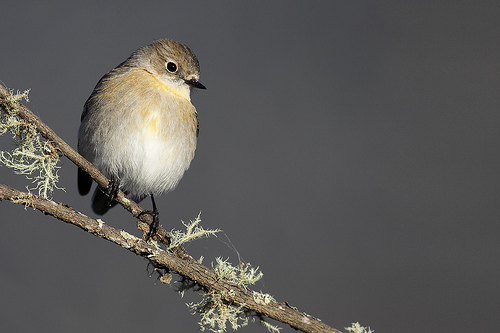Colours
Distinguishing features
The male is easily distinguished by its bright orange-red plumage of the throat, breast and abdomen. The crown, nape, ear coverts, hindneck, and sides of neck are dark grey, and lores and chin are a grey-black. The grey feathers of the sides of the crown may be suffused with dull orange. The rest of the upperparts, comprising the wings, back and tail, are dark grey. There is a small white frontal spot above the bill, and the wing bar and outer tail shafts are white. The feathers of the posterior belly, flanks and vent are white with grey-black bases.
The female is plainly coloured—pale brown overall, and a lighter buff underneath. The posterior belly, flanks and vent are off-white. As in the male, feathers on the side of the crown may be suffused with a dull orange, and this may also occur with breast feathers. There are small off-white marks on the wings and above the bill. The bill, legs, feet and claws are black, and the eyes dark brown.
The plumage of juvenile birds in their first moult resembles that of the adult female, but the head and upperparts are streaked and slightly darker. (Wikipedia)
Size
- From 12 cm to 14 cm (Length of specimen)
Wingspan
- Wingspan data is not yet available.
Synonyms
Interesting facts
- The Fan-tailed Cuckoo (Cacomantis (Cacomantis) flabelliformis) and Pallid Cuckoo (Cuculus (Cuculus) pallidus) have been recorded as brood parasites of the Flame Robin. (Wikipedia)
Distribution
Distribution and habitat preferences
It is found in temperate regions of southeastern Australia and all over Tasmania, although it is less common in the southwest and west. In Victoria, it is more common in uplands than lower altitudes.
It ranges from the Adelaide and Murray Plains around the mouth of the Murray River in southeastern South Australia, across Victoria and into the South West Slopes and southern regions of New South Wales. Further north, it is found along the Great Dividing Range and its western slopes, with a few records from southeast Queensland.
Within its range, it is generally migratory, moving from alpine and subalpine regions to lowlands in winter, although the breeding and non-breeding ranges overlap.
They are frequently encountered at high elevations on the Great Dividing Range, especially in sparser snow gum woodland and similar habitat, and during the summer breeding season are one of the most reliably observed species around the summit of Mount Macedon, NW of Melbourne.
In spring and summer, the Flame Robin is more often found in wet eucalypt forest in hilly or mountainous areas, particularly the tops and slopes, to an elevation of 1800 m.
It generally prefers areas with more clearings and less understory. In particular it prefers tall forests dominated by such trees as snow gum (Eucalyptus pauciflora), mountain ash ( E. regnans), alpine ash (E. delegatensis), manna gum (E. viminalis), messmate stringybark (E. obliqua), black gum (E. aggregata), white mountain gum (E. dalrympleana), brown barrel (E. fastigata), narrow-leaved peppermint (E. radiata), and black peppermint (E. amygdalina). It is occasionally encountered in temperate rainforest. In the autumn and winter, birds move to more open areas such as grasslands and open woodlands, such as those containing river red gum (E. camaldulensis), Blakely's red gum (E. blakelyi), yellow box (E. melliodora), grey box (E. microcarpa), and mugga ironbark (E. sideroxylon), at lower altitude. (Wikipedia)
Diet
It is a perch and pounce hunter, mainly eating insects, and often returning to a favourite low perch several times to stand erect and motionless, scanning the leaf-litter for more prey.
Among the types of insects consumed are many families of beetles, wasps and ants, flies (families Tabanidae and Asilidae), bugs, and caterpillars. Other invertebrates eaten include spiders, millipedes and earthworms. The Flame Robin consumes small prey items whole, and bashes larger victims against a hard surface repeatedly to break up before eating. (Wikipedia)



